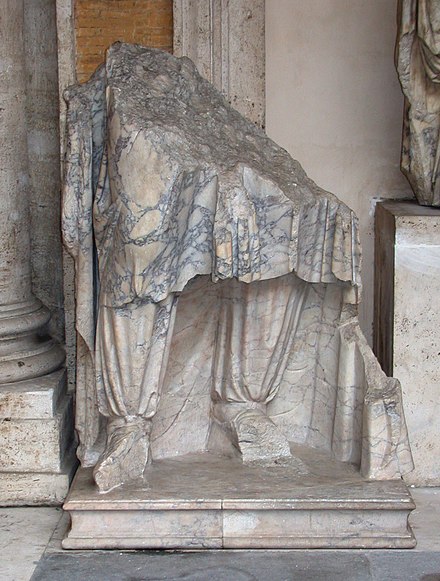Pavonazzo marble
.JPG/440px-Ritratto_femminile_-_MC_428_-_Musei_Capitolini_(2).JPG)

Pavonazzo marble, also known as Pavonazzetto, Docimaean marble or Synnadic marble,[1] is a whitish marble originally from Docimium, or modern İscehisar, Turkey.[2][3]
Etymology
The name derives from the Italian word for peacock (pavone).
History
Ancient world

Pavonazzetto was not widely or extensively used before the Roman period; there is no evidence of it in circulation before the last two decades BC.[4] The marble has been used in Rome since the Augustan age, when large-scale quarrying began at Docimium, and columns of it were used in the House of Augustus, as well as in the Temple of Mars Ultor, which also had pavonazzo floor tiles in the cella. Pavonazzetto statues of kneeling Phrygian barbarians existed in the Basilica Aemilia and Horti Sallustiani. Giant statue groups carved from Docimaean marble were discovered at Tiberius's Villa in Sperlonga.
Docimian Pavonazzetto was extensively used in major building projects both within Rome and the rest of the empire. Pavonazzetto was used on the most eye catching places such as, columns, wall and floor veneer and wall reliefs. Other marbles from all corners of the empire were used in combination; whenever Pavonazzetto was used as floor cover, it was usually in combination with other decorative marbles, however, the Pavonazzetto being a primarily white marble, it gave buildings a freshening white color.
Docimian marble was also preferred for sarcophagi sculpting, many emperors preferring this marble for its high value and majestic looks. As a result, some of the greatest masterpieces were made from this material, including the sarcophagi of Eudocia, Heraclius and many more.[5]
Later Use
Docimaean Pavonazzo was later used for the Memoria Petri, the tomb of Saint Peter, in the influential Baroque Revival style historic buildings the Church of St. Ignatius Loyola, in New York City, and Belfast City Hall in Belfast, Northern Ireland.
List of buildings with Pavonazzo marble
Buildings in Rome
- The Pantheon contains Docimian Pavonazzetto as floor pavement along with other marble types.[6][7] The dominant white color is the Pavonazzetto, also some of the interior main columns and pilasters are made from Docimian marble.[8]
- Forum of Augustus[9]
- Forum of Trajan (floor and 184 column shafts)[10][11][12]
- Temple of Mars Ultor (floor)[13]
- Temple of Apollo (floor)[14]
- Basilica Aemelia (20 statues)[15][16]
- Basilica Julia (floor and some columns)[17][18]
- Basilica Ulpia (some of the columns)[19]
- Basilica of San Paolo fuori le Mura (24 columns, destroyed by fire in 1823)[20]
- The eight statues on the Arch of Constantine[21]
- Baths of Caracalla (some of the columns and wall veneer)[22][23]

Buildings outside of Rome
- The Hagia Sophia has Docimian marble as veneer on the aisles and galleries.[24]
- The heart of Catholic Christianity, Saint Peter's Basilica, as veneer.[25]
- Leptis Magna, former limestone columns were replaced with Pavonazzetto.[26]
- Library of Celsus, the columns on the famous wall.[27]
- Ancient City of Sagalassos, as wall and floor covering, 40 tons of veneer were recovered.[28][29]
- Temple of Zeus and Hera in Greece, 100 columns and wall.[30]
See also
References
- ^ Strabo. Geography. "Book 9, chapter 5, section 16"
- ^ Erica Highes (2013). Meaning and λόγος: Proceedings from the Early Professional Interdisciplinary. University of Liverpool. p. 29. ISBN 9781443873505.
- ^ Elise A. Friedland (2015). The Oxford Handbook of Roman Sculpture. p. 181. ISBN 9780190266875.
- ^ Matthias Bruno, et al. “The Docimium Marble Sculptures of the Grotto of Tiberius at Sperlonga.” American Journal of Archaeology, vol. 119, no. 3, 2015, pp. 375–394.
- ^ Donato Attanasio; Mauro Brilli (2006). The Isotopic Signature of Classical Marbles. p. 151. ISBN 9788882653781.
- ^ Anthony Grafton (2010). Classical Tradition, Harvard University. p. 842. ISBN 9780674035720.
- ^ William Lloyd Macdonald (2002). The Pantheon, Harvard University. p. 86. ISBN 9780674010192.
- ^ J. Clayton Fant (1989). Cavum Antrum Phrygia. p. 8. ISBN 9780860546191.
- ^ Kathleen S.Lamp (2013). A City of Marble, University of South Carolina. ISBN 9781611173369.
- ^ Gaynor Aaltonen (2008). The History of Architecture. ISBN 9781782127970.chapter, ROME: CROSSING CONTINENTS
- ^ James E. Packer (2001). The Forum of Trajan in Rome. p. 120. ISBN 9780520226739.
- ^ Ben Russell (2013). The Economics of Roman Stone Trade, Oxford University. p. 229. ISBN 9780199656394.
- ^ John W. Stamper (2005). The Architecture of Roman Temples, Cambridge University. p. 137. ISBN 9780521810685.
- ^ John W. Stamper (2005). The Architecture of Roman Temples, Cambridge University. p. 136. ISBN 9780521810685.
- ^ Max Schvoerer (1999). ASMOSIA 4, University of Bordeaux. p. 278. ISBN 9782867812446.
- ^ Gilbert J. Gorski (2015). The Roman Forum, Cambridge University. p. 19. ISBN 9780521192446.
- ^ Gregor Kalas (2015). Restoration of The Roman Forum in Late Antiquity, University of Texas. p. 43. ISBN 9780292767423.
- ^ J. Clayton Fant (1989). Cavum antrum Phrygia. p. 8. ISBN 9780860546191.
- ^ L. Richardson (1992). A New Topographical Dictionnary of Ancient Rome, The Johns Hopkins University. p. 176. ISBN 9780801843006.
- ^ Lawrence Nees (2015). Perspective on Early Islamic Art in Jerusalem. p. 107. ISBN 9789004302075.
- ^ Russell, Ben (2014). The Economics of the Roman Stone Trade, Oxford University. p. 324. ISBN 9780199656394.
- ^ Janet DeLaine (1997). The Baths of Caracalla. p. 32,70. ISBN 9781887829250.
- ^ Dante Giuliano Bartoli (2008). Marble Transport in the Time of the Severans, Texas University (PDF). p. 154. Archived (PDF) from the original on 2022-10-09.
- ^ Nadine Schibille (2014). Hagia Sophia and the Byzantine Aesthetic Experience, University of Sussex. pp. 241–242. ISBN 9781317124153.
- ^ Keith Miller (2011). St. Peter's, Harvard University. p. 110. ISBN 9780674069060.
- ^ Ben Russell (2014). The Economic of the Roman Stone Trade, Oxford University. p. 28. ISBN 9780199656394.
- ^ Barbara E. Borg (2015). A Companion to Roman Art. p. 124. ISBN 9781118886090.
- ^ Abu Jaber; N. Bloxam. QuarryScapes, Geological Survey of Norway (PDF). p. 102. Archived (PDF) from the original on 2022-10-09.
- ^ Marc Waelkens (2000). Sagalassos Five, Leuven University. p. 339. ISBN 9789058670793.
- ^ Pausanias. Book 1 Attica 16-29, Athens. Book, 1,18,9